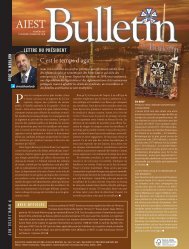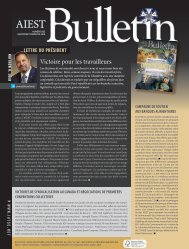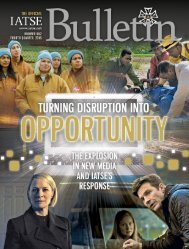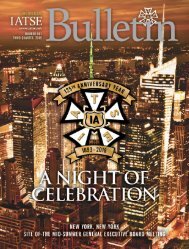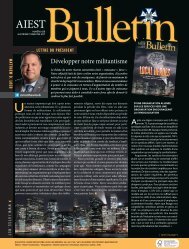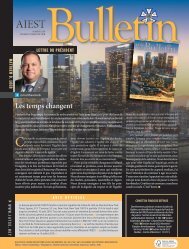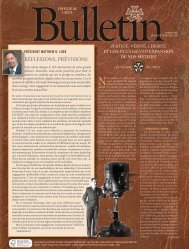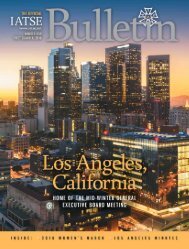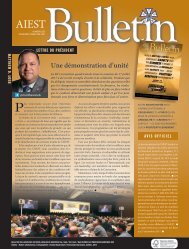IATSE-2nd2018_web
Create successful ePaper yourself
Turn your PDF publications into a flip-book with our unique Google optimized e-Paper software.
away in the dead of night, leaving them to walk the rails back<br />
home. Wages were cut arbitrarily and discriminatory practices<br />
were common.<br />
Many road shows employed non-union crews, paying them<br />
little and forcing them to work long hours. When strikes took<br />
place, there was always a conflict between the local membership,<br />
the road stagehands, and unscrupulous workers who would<br />
come from other cities to break the strike.<br />
However, out of these challenges came opportunities.<br />
When traveling stagehands were left stranded in distant locations,<br />
they turned lemons into lemonade, working to bring<br />
local workers into the Alliance. These early organizing efforts<br />
spread the word about what union representation could to do<br />
improve stagehands’ lives.<br />
And in 1912, at the 20th Convention, <strong>IATSE</strong> established the<br />
first blanket contract for road workers guaranteeing theirtransportation<br />
home as well as two weeks’ pay for shows that suddenly<br />
closed. At the same time, District No. 1, composed of Locals<br />
in the Northwest, created a system which allowed road workers<br />
to send basic information, such as the size of the crew and the<br />
length of time they would be needed, on to the next destination.<br />
This ensured that not only that there would be enough people to<br />
staff each theater, but that they would be union crews.<br />
This system worked so well that the International adopted<br />
it a few years later. It continues today as the Yellow Card system.<br />
THE ALLIANCE’S GOVERNANCE MATURES<br />
Without an international headquarters and with a rapidly<br />
rotating series of Presidents, who had only been paid since 1906,<br />
<strong>IATSE</strong> sought to expand its authority and centralize its operations.<br />
At the 1909 Convention, delegates approved the creation of<br />
seven districts which would each be responsible for winning fair<br />
wages and working conditions in the theaters in their respective<br />
regions. These District Councils ended up being very important in<br />
fighting for the workers’ rights. The theaters were often owned by<br />
the same manager or chains, without the Councils, it would have<br />
been difficult to confront these chains and win equitable wage increases<br />
for the many local unions which operated in the area.<br />
At the next year’s Convention, after long and heated<br />
arguments on the floor, the delegates gave the President and<br />
Executive Board the authority to levy fines and other penalties.<br />
In 1913, delegates voted to move from annual to biennial<br />
conventions. Our modern-day conventions follow the same<br />
traditions as these early ones, addressing challenges, identifying<br />
opportunities, enacting legislation, and hearing and<br />
resolving complaints and appeals. That same year, <strong>IATSE</strong> established<br />
its international headquarters in New York City and<br />
required that the President and General Secretary-Treasurer<br />
live and work there. At last, the Alliance had leaders with genuine<br />
authority to conduct the business of the union.<br />
But this did not mean smooth sailing. Initially, the Executive<br />
Board was composed of the President and four “at-large” Vice<br />
Presidents, which inevitably led to regional conflicts among the<br />
Locals. The Alliance tried establishing Eastern and Western Executive<br />
Boards, but when this failed to succeed, they settled on a<br />
board composed of the President, regional Vice Presidents, and<br />
the General Secretary-Treasurer.<br />
The President was given very broad powers, including the<br />
authority during an emergency to suspend the laws of <strong>IATSE</strong><br />
and any local unions as long as he obtained unanimous consent<br />
of the General Executive Board.<br />
Throughout these early years, <strong>IATSE</strong> membership rose rapidly,<br />
from 1,500 in 1893 to 3,700 in 1900 and more than 21,000<br />
members in 1920. The number of<br />
local unions also grew at a speedy<br />
pace, first in the cities and later in<br />
the more remote areas.<br />
11






